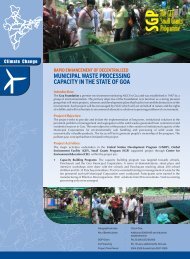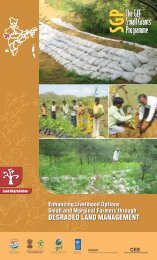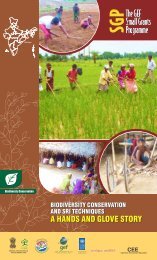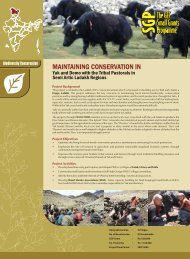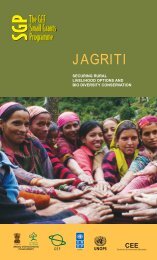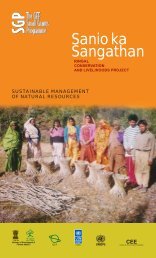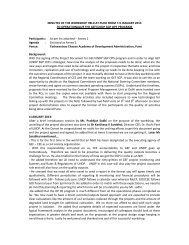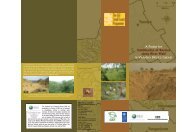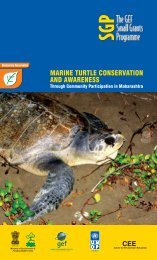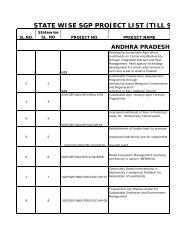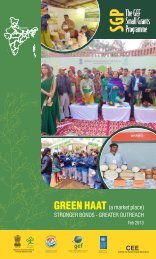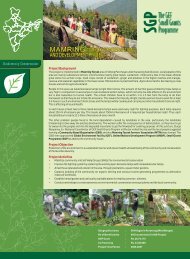COUNTRY INDIA
Country Programme Landscape Strategy - SGP India
Country Programme Landscape Strategy - SGP India
Create successful ePaper yourself
Turn your PDF publications into a flip-book with our unique Google optimized e-Paper software.
<strong>COUNTRY</strong> PROGRAMME LANDSCAPE STRATEGY FOR<br />
COMMUNITY DEVELOPMENT AND KNOWLEDGE MANAGEMENT (COMDEKS)<br />
<strong>COUNTRY</strong>: <strong>INDIA</strong><br />
TABLE OF CONTENTS<br />
Summary..........................................................................................................................................1<br />
The Chosen Landscape ....................................................................................................................2<br />
Approach & Expected Outcome ......................................................................................................3<br />
Priority Area.....................................................................................................................................4<br />
Topography.............................................................................................................................5<br />
Climate....................................................................................................................................5<br />
Drainage..................................................................................................................................6<br />
Land Use Pattern.....................................................................................................................6<br />
Soils.........................................................................................................................................6<br />
Crops.......................................................................................................................................7<br />
People......................................................................................................................................7<br />
Situation Analysis ............................................................................................................................9<br />
Brief Summary of Landscape ........................................................................................................11<br />
Landscape Strategy ........................................................................................................................15<br />
Proposed Strategy ..........................................................................................................................16<br />
Expected Outcomes .......................................................................................................................19<br />
Typology of potential community-based projects and criteria for project selection .....................19<br />
GEF/ UNDP SGP National Steering Committee meetings for COMDEKS .................................20<br />
Monitoring & Evaluation...............................................................................................................21<br />
Knowledge Management Plan .......................................................................................................22
<strong>COUNTRY</strong> PROGRAMME LANDSCAPE STRATEGY FOR<br />
COMMUNITY DEVELOPMENT AND KNOWLEDGE MANAGEMENT (COMDEKS)<br />
<strong>COUNTRY</strong>: <strong>INDIA</strong><br />
Summary<br />
India is among the most diverse nations of the world from a cultural, natural endowment, and<br />
socio-economic standpoint. It enjoys a long history that makes it a unique country and one where<br />
culture and tradition is embedded in everyday living. Given the current economic boom, while<br />
urban India chooses to move on through evolved contemporary thinking, the lives of rural<br />
community members are still entirely dependent on nature, and as such they respect it for its role<br />
in everyday living and believe in its sustainability. Mountain regions in particular are affected by<br />
nature’s vulnerability and this fact, along with increased dependence on nature and forests for<br />
daily needs results in communities also being deeply religious leading to daily life being<br />
governed by inherited traditions and beliefs.<br />
This is what makes COMDEKS 1 , built on the Satoyama Initiative framework, very relevant at a<br />
philosophical and practicable level for enhancing sustainable practices that follow a landscape<br />
approach. More importantly it is an initiative that conceptually will not seem imposed and can be<br />
practiced at ease by mountain communities within the Indian sub-continent, since there is<br />
congruity of thought. It is also for this reason that Uttarakhand suits as a site to house the pilots<br />
on such a landscape approach, given the region’s respect for such a philosophy and high level of<br />
dependability on nature, yet the vulnerability it faces on account of man induced natural<br />
phenomenon. The region also suffers on account of a lack of deeper understanding to its<br />
problems since policy makers focus limitedly in understanding the constraints and realities of<br />
mountain regions. As such COMDEKS comes in as a breath of fresh air to infuse needed<br />
strategic focus to a much needed neglected subject.<br />
Communities residing within the mountain system in India earn their living through a<br />
multiplicity of livelihood pursuit. As such the integration needed between forestry, agriculture,<br />
and animal husbandry, among others is an ongoing phenomenon and one for which there is<br />
appreciation by all stakeholders. However, forces of the market as well as constraints such as<br />
animal menace, fragmentation of land holdings, and outward migration are all testing traditional<br />
systems and bringing sustainable practices under threat. Of late, communities within Uttarakhand<br />
state living in the area chosen for COMDEKS implementation in India, have started to develop a<br />
better understanding of markets and needed adaptive strategies to adjust to aspects of climate<br />
change and this is a welcome development. This has resulted in avenues opening up in tourism,<br />
dairying, agriculture, value addition to the Non Timber Forest Produce (NTFP), among others,<br />
and each such initiative connects to traditional knowledge and its surrounding wisdom, though<br />
1 Funded by the Japan Biodiversity Fund, the Community Development and Knowledge Management for the<br />
Satoyama Initiative Project (COMDEKS) is a unique global project implemented by UNDP, and delivered through<br />
the Small Grants Programme as the flagship of the International Partnership for the Satoyama Initiative. Indiai is one<br />
of countries taking part in this global pilot, together with Brazil, Cambodia, Ethiopia, Fiji, Ghana, Malawi, Nepal,<br />
Slovakia, and Turkey. The main objective of the Project is to develop sound biodiversity management and<br />
sustainable livelihood activities with local communities in socio-ecological production landscapes to maintain,<br />
rebuild, and revitalize landscapes.<br />
COMDEKS <strong>INDIA</strong> Page 1 of 22
seeking contemporary scientific and societal validation. However, gaps are evident at the policy<br />
level compounded by weak ongoing support from the state system, as also poor infrastructure<br />
that poses challenges to mainstreaming.<br />
However, the belief and willingness of communities residing in such landscapes holds hope to<br />
pursue a path of sustainable landscape based living, and one that will be appreciated by the world<br />
for its contextual relevance. It is thus important to address the needs of such communities who<br />
largely also hold a larger responsibility of being custodians of nature and forests for a nation<br />
keen to develop industrially. COMDEKS and Satoyama Initiative can thus contribute to and<br />
learn from this core need in a large measure, with the emerging learning being relevant for<br />
scaling up the program geographically in other parts of the world.<br />
The Chosen Landscape<br />
Overall 3 landscapes within the Himalayan state of Uttarakhand have been covered for the<br />
baseline study forming part of the larger Himalayan Eco-system.<br />
The first landscape, Rasulpur is located in the foothills of the Himalayas but is impacted on<br />
account of forest dwellers driven out of the designated Rajaji National Park without any<br />
compensatory rights. Being cattle grazers the pressure to feed needs of households is forcing<br />
them into pursuing activities that are wreaking havoc in the local ecosystem within and adjoining<br />
Rajaji National Park, and as such needs to be addressed through more focused landscape-based<br />
diverse livelihoods actions.<br />
The second landscape being addressed is Shankarpur, also set in the foothills of the Himalayas<br />
where much damage is being caused to existing farmlands through heightened ravine activity<br />
due to flash floods from rivers originating in the hills. This has eroded land, widened river banks<br />
and is now threatening the pursuit of agriculture.<br />
The third landscape has varying locations that forms part of the mid-high Himalayan system<br />
though with smaller variances of altitude in the local context. This region has an important role<br />
to play in meeting overall ecological endowment needs and as such has too many expectations<br />
from it, yet is moving to a state of extreme fragility.<br />
Given these factors, varying activities endemic to the region were probed for pursuit such as<br />
tourism, traditional foods and systems, forest livelihoods and woodlots, medicinal plants,<br />
dairying, and handicrafts; as well as value-added opportunities in dairying, herbs, and traditional<br />
foods.<br />
Though people still prevalently practice agriculture, it functions as a subsistence activity that<br />
needs to improve in order to become a sustainable occupation giving commensurate returns.<br />
Agriculture directly deals with food and nutritional security of the region but has become<br />
unproductive due to factors such as migration, marginal and fragmented land holding, weather<br />
changes, and market forces; and has thus stopped being meaningful. Without an added value to<br />
the existing agriculture system the community is moving towards migration and alternative<br />
income source that can have an impact on the quality of land, which is the main component of<br />
any landscape. On another count, given the rate of migration, women have become the backbone<br />
of agriculture that is primarily pursued as a traditional practice putting further load on them.<br />
Decent level of literacy has helped available workforce to earn their livelihood from privately<br />
owned small shops or working in factories in larger cities beyond their region. This is reflected<br />
COMDEKS <strong>INDIA</strong> Page 2 of 22
through most homes in villages having a family member working in the public sector or defence<br />
establishment. Remittances constitute a major inward cash flow component into the family kitty.<br />
Agriculture today is a major activity but not economically strong to create dependence or sustain<br />
as a reliable source of income. Therefore the focus will be to encourage local youth who are<br />
socially committed, and have a desire to contribute to raising eco-sensitivity and promoting<br />
cultural practices to gain skills and knowledge for reinforced livelihoods and enterprises relevant<br />
to needs of the region.<br />
Approach and Expected Outcome<br />
The overall approach will be based on the main perspectives of Satoyama Initiative approach,<br />
that focus on ensuring that communities live in harmony with nature with a clear emphasis on<br />
resource use within the carrying capacity and resilience of the environment, cyclic use of natural<br />
resources, recognition of the value and importance of local traditions and cultures, natural<br />
resource management by various participating and cooperating entities, and contributions to local<br />
socio-economies.<br />
Some of the outcomes expected to emerge are:<br />
1. Enhanced provision of ecosystem services within the target landscapes through<br />
conservation activities and sustainable use of natural resources.<br />
2. Improved agricultural productivity in the target landscape by promoting sound and<br />
sustainable agricultural practices, resulting in increased food security and income<br />
generation.<br />
3. Alternative livelihoods options promoted within the landscape to enable access to<br />
markets and local financial institutions.<br />
4. Institutional systems strengthened at the landscape level by promoting sharing of<br />
knowledge and information on effective use of resources and landscape related issues,<br />
and a more participatory decision making in the target landscapes.<br />
5. A new learning having emerged and shared as a winning example of a doable approach<br />
for others to emulate.<br />
COMDEKS <strong>INDIA</strong> Page 3 of 22
Priority Area<br />
COMDEKS in India is proposed to be implemented in the mountain state of Uttarakhand that<br />
offers the perfect setting to roll out the Satoyama philosophy through the COMDEKS<br />
programme. Nestled in the Himalayas, Uttarakhand is a location where the role of nature and<br />
dependencies on it are more pronounced, and where GEF UNDP SGP has already many ongoing<br />
projects.<br />
Physiographic map of Uttarakhand with location indicated within India<br />
Source: http://uttarakhand.org/?portfolio=relief-map<br />
The north Indian state of Uttarakhand was formed on November 9, 2000 as India’s 27th state<br />
coming into existence at the culmination of a long-standing struggle for separate statehood. The<br />
state comprises 13 districts distributed over two administrative divisions, Garhwal and Kumaon<br />
with the state’s capital located at Dehradun in Garhwal. It extends between 77° 34’ and 81° 02’<br />
E longitude and between 28° 43’ to 31° 27’ N latitude and has international boundaries in north<br />
and west with Tibet and Nepal respectively. To the west and northwest is the Indian state of<br />
Himachal Pradesh, while the Uttar Pradesh state forming part of Gangetic plains are to the South.<br />
Uttarakhand is spread over 53,483 sq. km. of land, of which 46,035 sq. km. is classified as hill<br />
region and only 7,448 sq. km as plains. Of the total, 34,651 sq. km is under forest cover. The<br />
2011 census reported a population of 10.12 million, with a near equal gender divide and nearly<br />
COMDEKS <strong>INDIA</strong> Page 4 of 22
70% of the population residing in rural areas. The entire state forms part of the Central<br />
Himalayas starting from the foothills in the South and extending to the snow clad mountains in<br />
the north. Uttarakhand is interspersed with rivers, deep valleys, glaciers, and high peaks and<br />
presents a very pristine, pure and picturesque landscape. Given the traditional culture and beliefs<br />
that are still trusted and respected, it is no wonder that it is also considered to be the abode of<br />
Gods and Goddesses with many temples and shrines dotting the landscape.<br />
Topography<br />
The Himalayan chain that Uttarakhand forms part of originated from the continent to continent<br />
collision of the Eurasian and Indian plates. The Himalayas (meaning the abode of snow) was<br />
formed as a result of northward drift of the Indian plate after its split from the Gondwana – land;<br />
consumption of intervening oceanic crust of the Neotethys; and then its collision with the<br />
Tibetan plate during the Eocene period. The continued collision process caused the crustal<br />
shortening on the northern margin of India as well as the southern margin of Tibet.<br />
A vulnerable section encountered during travel through Uttarakhand<br />
Uttarakhand’s altitude shows a wide variation from about 350m in the southern plains to about<br />
7,800 m on the mountain peaks and passes in the northern part towards the international border<br />
with Tibet. The Himalayan axis, running from South East to North West is home to major peaks<br />
such as Nanda Devi (7816 m), Kamet Mana (7756 m), Chaukhamba (7138 m), Trisul (7120 m),<br />
and Dronagiri (7066 m).<br />
Climate<br />
The state has average rainfall of 1,606 mm. with the weather and climate of Uttarakhand mainly<br />
governed by the summer and winter monsoon systems of Asia. The winter rain is brought in by<br />
the ‘western disturbance’ and the summer rain by summer monsoon winds. There is wide<br />
variation in the rainfall distribution in the region with areas towards the north that fall within the<br />
rain shadow having very little rainfall. Rainfall is also very low in the interior regions but during<br />
monsoon, the region can be prone to landslides and floods; and at times cloud bursts causing<br />
unusually heavy rainfall, leading often to disastrous flash floods. The higher chain of the<br />
mountain range gets major part of precipitation as snow fall during December to February.<br />
COMDEKS <strong>INDIA</strong> Page 5 of 22
Each mountain is unique in itself with respect to amount of precipitation, temperature and<br />
climate. Towards higher reaches, the air is thin and radiation is intense as ultraviolet radiation is<br />
not filtered by the thin air. The temperature varies greatly from place to place with maximum<br />
temperature in 2010 reaching up to 41.2°C during summer (May-June) in Dehradun, and<br />
minimum falling to -2.3°C during winter (Jan-Feb.) in Mukteshwar and surrounding regions.<br />
Summers are extremely hot in the valleys and pool frosts are common during winter. Generally,<br />
the winters are severe and the summers pleasant. Broadly, four seasons can be recognized;<br />
namely winter from November to March, summer from April to mid-June, monsoon from July to<br />
mid-September, and autumn from mid-September to October/November.<br />
Drainage<br />
Himalayas are the youngest; tectonically active and structurally a very complicated mountain<br />
range, from where a number of perennial rivers originate that provide sustenance to vast masses<br />
of people in the valleys and rich alluvial plains of the country. A number of important rivers like<br />
Ganges, Yamuna, Kali (Sarda), Dhauli, Gori, Ramganga (Eastern), Alaknanda, Bhagirathi and<br />
Tons etc. arise from its axis. The major rivers have their catchment separated by secondary<br />
mountain ranges arising from the main Himalayan axis and flow mainly North-East to South-<br />
West. Tributaries of the main rivers have their catchments separated by secondary mountain<br />
ranges arising from main rivers with their source in these secondary ranges.<br />
The forest cover on these hill ranges is instrumental in regulating the extent of precipitation in<br />
the region and also the flow of water in its streams. This mountain system has a dominant<br />
influence on the water regime, temperature, humidity and ecological balance of northern India.<br />
Snow or rain on its slopes feeds a number of perennial streams and rivers that flow down to<br />
plains below. With limited options exercised at the local levels as a priority in water harvesting<br />
most of the water is lost through perennial river flows.<br />
Land Use Pattern<br />
Most of the area is under forests and wastelands thus leaving behind only a small amount of land<br />
(about 12 percent) for cultivation. As of 2009-10 the net sown area was 741,099 ha. constituting<br />
13.8% of the total land area of the state, much of it taken up by forests. In terms of land holding;<br />
71.4% was held by marginal farmers (
egion by way of flash floods during rains followed by excessive drought and shortage of<br />
drinking water during dry summer months. This causes untold misery to the people inhabiting<br />
the hills and also those in plains below. Rapid surface runoff has washed the rich top soils and<br />
has thus rendered vast stretches of land infertile, unproductive and uneconomic for cultivation.<br />
Gully formation torrents and land slides erosion are not only damaging productive land but also<br />
destroying habitations and disrupting the communication and transport system as well as<br />
perennial sources of supply. Maize is also grown on the sloppy land leading to erosion at scales.<br />
Crops<br />
Generally agriculture practices vary depending farmers being part of rainfed or irrigated areas.<br />
Cereals are emphasized in irrigated agriculture and two crops can be taken in an agriculture year.<br />
However in the rain fed system; millets, maize, pulses, and tuber crops are grown along with<br />
cereals and oilseeds. Mono-cropping is a common practice in irrigated areas and contrary to this<br />
mixed cropping is common in rainfed areas. Mixed cropping, practiced in the hilly region helps<br />
in maintaining crop diversity and reduces the risk of environmental uncertainty.<br />
The cultivation pattern in Uttarakhand reflects a declining trend in acreage of conventional crops<br />
like barley and at the same time increase in non conventional crops like soybean and vegetable<br />
crops. Farmers are gradually shifting from cultivation of low value crops to high value crops.<br />
The decline in the area under traditional crop has been relatively higher in the Kharif (monsoon)<br />
season as compared to Rabi (winter) season. During the kharif season the farmers are putting a<br />
sizable land area towards production of off-season vegetables. The land under production of<br />
traditional Kharif crop has declined at 10 percent as against 8 percent for Rabi crop. Despite the<br />
small holdings, most farmers who are relatively well connected to the market and have adequate<br />
irrigation facility have opted for a shift in production from low value food grains to high value<br />
commercial crops particularly vegetable and pulses.<br />
Farming situation Soil Principal crops<br />
Irrigated lower hills Alluvial sandy soil Rice, wheat, onion, chillies, peas, potato, radish,<br />
(600-1200m.)<br />
cauliflower<br />
Rainfed lower hills Residual sandy loam Finger millet, maize, rice, wheat<br />
(600-1200 m.)<br />
Mid hills south aspect Sandy loam<br />
Rice, finger millet, wheat, potato, tomato<br />
(1200-1700 m.)<br />
Mid hills north aspect Brown forest soil Rice, finger millet, maize, wheat, potato, tomato,<br />
(1200-1700 m.)<br />
peas, cole crops<br />
High<br />
hills Red to dark<br />
Amaranth, finger millet, french bean, cole crops,<br />
(1700-2500 m.)<br />
potato, peas<br />
Very high hills Red to dark Black clay Amaranth, buckwheat, peas, loam cole crops,<br />
(2500-3500 m.)<br />
potato<br />
Source: Uttarakhand Statehood, M.C. Sati & S.P. Sati<br />
Other than food grains and fruits, the hilly region also provides valuable timber, fuel wood,<br />
fodder, fiber, herbs, and other varied NTFPs for subsistence of the population.<br />
People: Life in the mountain region of Uttarakhand is tough, strained further by challenging<br />
dynamics that are created by nature and man. Landholdings are small and spread over a large<br />
area making pursuit of common forms of livelihoods such as dairying and farming more<br />
difficult. This is one of the primary reasons for migration of male members of the household in<br />
order to eke a living for their family. This forces the burden of managing the landscape and<br />
family on the women of the house who are already overburdened given their need to pay<br />
COMDEKS <strong>INDIA</strong> Page 7 of 22
attention to daily routine needs of cooking, children, and other domestic chores. Beyond this they<br />
are expected to source fodder for cattle, fuel wood for cooking, and water for which she has to<br />
ravel a long distance and carry a big burden on her nimble shoulders since such material is no<br />
longer available close to the village. Limited access to information, limited skills and exposure,<br />
non availability of timely access to credit from banks further worsens the debt burden of the<br />
locals. Communities are under constant pressures for sustainable lives and livelihoods.<br />
As such, development interventions being planned needs to be thought through with much care,<br />
and need to include actions for the reduction of drudgery faced by women in the hills, since they<br />
are the most dependent workforce available on regular basis currently, and success of the<br />
initiative will largely depend on their ability to participate whole heartedly. Supporting locally<br />
appropriate actions will lead to increase in local capacity.<br />
The GEF UNDP SGP projects promoted in the past in Uttarakhand have acknowledged these<br />
needs and fostered such needed efforts that has in a big way attributed to their success. These<br />
initiatives have been taken up through informal, kinship, common trade, and locally area-based<br />
women self -help groups (SHGs) led units that have been up scaled by establishing federations,<br />
producer companies/societies. This have also helped build on the women’s strong underlying<br />
conviction to nurture and protect the environment, while connecting and competing within the<br />
market system. The projects funded have helped fuel the entrepreneurship spirit lying latent in<br />
the population through a series of awareness, capacity building activities including needed skills<br />
to cope with a competitive market, and market supported efforts. The program has been able to<br />
respect learners’ ideas, participation, (in decisions, roles-responsibilities and small financial<br />
contributions) and knowledge.<br />
SGP has helped establish successful business models for forest and nature-based value-added<br />
products such as jams, squashes, pickles, spices, woolen knits, and embroidery. In this process,<br />
communities have been fully involved at all levels in project design and implementation,<br />
especially in regard to sustainable raw material sourcing, production, and linkage to markets.<br />
Establishment of biogas units has helped reduce women’s drudgery in sourcing fuelwood as well<br />
as provide essential fertilizers for agriculture. These are among some of the initiatives that<br />
include smokeless cook stoves, household nurseries, local small water harvesting structures and<br />
other related simple, low cost, easy-to-understand-and-implement technologies that have directly<br />
fed into the goals of OP5 in relation to sustainable land management, biodiversity conservation<br />
and energy efficiency and energy conservation. The COMDEKS Country Programme Landscape<br />
Strategy for India is aligned with the 5th Operational Phase of the GEF Small Grants Programme<br />
in India project’s primary objective which is to ensure a mosaic of land uses and community<br />
practices across the rural landscape that provide sustainable livelihoods while generating global<br />
benefits for BD, CC and LD. In particular, COMDEKS landscape strategy is in line with<br />
activities proposed under the first component; mainstream biodiversity conservation and<br />
sustainable use into production landscapes and sectors. Additionally, under COMDEKS the<br />
landscape approach will work in synergy with energy conservation/efficiency activities. The<br />
supported communities will gain exposure to low cost renewable technologies for energy<br />
efficiency and enhance their capacity to access credit. This will reduce their dependence on<br />
firewood, promote dedicated woodlots, and conservation of the biodiversity. Simple, low cost<br />
renewable technologies for drying, and energy efficiency will be introduced.<br />
In line with the overall GEF SGP OP5 mandate, the COMDEKS project in India seeks to bring<br />
about community development, learning, and knowledge sharing by making available small<br />
COMDEKS <strong>INDIA</strong> Page 8 of 22
grants to community organizations to help them maintain and manage more resilient socioecological<br />
production landscapes. It is expected that COMDEKS grants at the landscape level<br />
will be matched as cofinancing by an equal amount in regular funding from the Upgraded SGP<br />
Country Programme. The OP5 India Programme will fund NGOs/CBOs in the same geographic<br />
location but for differing relevant activities in support of the India COMDEKS strategy.<br />
Situation Analysis<br />
As is to be expected, the mountain livelihood system that once existed within a well balanced<br />
landscape has come under pressure with passage of time and increasing population density. As if<br />
hardships of daily living are not enough given the harsh realities of topography and nature,<br />
detrimental changes are putting increased pressure on communities living in such environments,<br />
thus negatively impacting the environment resulting from increasing needs and changed<br />
practices pursued by communities. The changing scenario is not only disrupting livelihoods but<br />
has also resulted in bringing increased pressure on natural resources, further impacting family<br />
life and resulting in increased outward migration. Further, lack of infrastructures and weak<br />
understanding of policy/decision makers in such landscapes have further aggravated the lot of<br />
mountain communities who live a life of greater hardship compared to their counterparts in the<br />
plains.<br />
While reasons for this degradation over time can be attributed to very many factors, with many<br />
discussed in the earlier section, the following constitute major reasons that have created this<br />
changed scenario over the years:<br />
1. Restriction on the forest based livelihood options available traditionally to community<br />
2. Access to technology and timely credit facilities to the communities so as to have better<br />
value-addied to the forest and nature based products<br />
3. Man animal conflicts due to depleting forest resources and ingress of the wildlife and<br />
impacting pursuit of agriculture<br />
4. Falling respect for biodiversity in the face of low knowledge of its importance, and<br />
pressing survival needs impacting its degradation and hence its relevance<br />
5. Climate change and shifting weather patterns, increased pressures from high cost<br />
agriculture practices to the more organic ways of productions systems based on the local<br />
sustainable practices.<br />
6. Pressure from increased demands and population for immediate incomes is leading to the<br />
replacement of diverse horticulture based systems to more mono cropping landscape<br />
systems of Paddy-Wheat crops.<br />
7. Poor relevance of centrally devised policy initiatives for integrated rural development,<br />
and related livelihood support that have weak relevance to mountain scenarios.<br />
8. Poor infrastructure and connectivity resulting in higher cost of inputs, also adding to<br />
output cost on account of lack of efficient linkage to markets.<br />
9. Outward migration driven from a need to earn a decent living standard.<br />
To understand ground realities that could contribute to building the foundation for the future<br />
COMDEKS effort, a baseline exercise was conducted as a first step. It comprised following<br />
processes taken up systematically commencing with a stakeholder consultation. Feedback<br />
gathered at the stakeholder consultation was later followed up with a day session with<br />
participating representatives of the landscapes chosen for baseline survey. The following steps<br />
followed formed part of efforts in the field:<br />
COMDEKS <strong>INDIA</strong> Page 9 of 22
° A one day initial briefing session and sitting with the existing GEF SGP partners and NGO<br />
partners to outline the features of the COMDEKS program and understand past efforts and<br />
typicality of the landscape they had worked in. This resulted in filling up of a Data Sheet<br />
form in collaboration with the partner.<br />
° Sharing of a background note with GEF SGP and other NGO partners outlining COMDEKS<br />
objectives and processes to be adopted (and needs for) the baseline study<br />
° Community meeting at the 7/8 different field locations in the state, each apart at least 50-70<br />
km to undertake with community members the map making exercise that helped them<br />
prepare and validate the maps of participating villages.<br />
° Administration and recording of 20 key questions comprising a set of resilience indicators in<br />
socio-ecological production landscapes, developed by IPSI members Bioversity International<br />
and UNU-IAS, and piloted by the COMDEKS Project as part of a baseline study through a<br />
system of cards and board based interactions with partners at every location.<br />
° Plotting of all responses on Excel sheet provided by COMDEKS program office.<br />
COMDEKS Baseline Study Locations<br />
(markings are approximate, refer below for co-ordinates)<br />
Relief Map Courtesy: http://uttarakhand.org/?portfolio=relief-map<br />
The six locations identified (see map above) for COMDEKS baseline study were drawn up with<br />
GEF UNDP SGP team in a consultative manner based on impacting factors suggested below:<br />
° Biodiversity and ethnic value traits prevalent in region and now coming under pressure<br />
° State of distress and declining quality of life, unreached areas<br />
COMDEKS <strong>INDIA</strong> Page 10 of 22
° Existing partners working and trust worthy relations existing in the areas<br />
° Base of local traditional knowledge and practices<br />
° Need to bring and converge interventions to the local governance systems<br />
° Opportunity to enhance sustainable management practices on landscape bases as the mandate<br />
of COMDEKS<br />
The table below indicates the co-ordinates of the chosen six locations:<br />
Location Co-ordinates/Altitude (mtrs) Location Co-ordinates/Altitude (mtrs)<br />
Pipalkoti N 30°43’53.6” E 79°42’78.7”/ 2415 Tadikhet N 29°37’20.6” E 79°25’ 23.5”/ 1860<br />
Shankarpur N 30°39’84” E 77°84’15”/ 458 Galli Basura N 29°41’32.6” E 79° 24’ 38.5”/ 1350<br />
Rasulpur N 30°01’18.7” E77°58’23.6”/ 325 Ranman N 29°44’68.3” E 79°37’31.0”/ 1409<br />
Brief Summary of Landscape<br />
Presented below is a brief summary of the six landscapes covered under the baseline study:<br />
While the background of the six landscapes has been covered on page 3 under the heading “The<br />
Chosen Landscape” it needs to be highlighted that Rasulpur and Shankarpur each share a<br />
different landscape though resting in the foothills of the Himalayas, but the other 4 locations<br />
share almost similar features of the Himalayan mountain region. Tadikhet, Ranikhet and Ranman<br />
can be approached on the same route and of these 3 locations, Ranikhet and Tadikhet share the<br />
same market. Activities supported in each location would need to be different but their interlinkage<br />
will benefit the overall landscape broadly. Landscape based activities supported by<br />
COMDEKS will help to link community efforts with markets helping the local community<br />
through a sustainable livelihoods approach.<br />
Rasulpur: Situated on the fringe of the Rajaji National Park, Haridwar; the area is home to the<br />
Tongias who though had been driven out of the national park, have not been rehabilitated in the<br />
fringe areas they reside in. SGP partner Friends of Doon Society has been active with the cause<br />
of the community who are essentially herders who have been living a forest based existence and<br />
are sensitive to the needs of such a landscape.<br />
Three villages Rasulpur, Rasulpur-Tongia and Daluwala Kalan; proposed to be covered under<br />
the intervention have a total of 490 households housing a population of 2,171. Activities pursued<br />
are largely farming, animal husbandry and other traditional skill based pursuits such as<br />
carpentry, tailoring, blacksmith, etc. Total cultivable land available is 3,859 ha, that currently<br />
grows cereals, pulses, sugarcane,<br />
and oil seeds though animal<br />
menace is discouraging its<br />
continued pursuit. Other than<br />
farming, poultry has been also<br />
introduced by Friends of Doon<br />
Society, Dehradun (FODS), a<br />
NGO working in the region, and<br />
is meeting with success. Most of<br />
the population falls under the<br />
below poverty line (BPL)<br />
category and suffers from lack of<br />
availability of basic health and<br />
The setting of Rasulpur village on the fringe of Rajaji National Park education facilities. Community<br />
COMDEKS <strong>INDIA</strong> Page 11 of 22
members are largely dependent on forest produce that with passage of time has become illegal to<br />
pursue, though the community is forced to turn to it to meet their needs, even though as an illegal<br />
activity. There is thus a need to realign their livelihoods to a more meaningful pursuit to fulfill<br />
their needs as also give the ecosystem a chance to maintain the needed balance.<br />
In terms of livelihoods activities in the target locations currently being visualized are<br />
afforestation, revival of existing and new water bodies, revival of traditional foods agriculture<br />
systems, medicinal plants, soil and water conservation actions, pasture development, and valueadded<br />
livelihood activities such as tourism, dairying, handicrafts & conservation, use and<br />
processing of local fruits, food items and medicinal plants for better value, all also promoting<br />
conservation of sacred natural sites, including heightening of the cultural, spiritual and socioeconomic<br />
values in the local societal system.<br />
Shankarpur: Shankarpur falls part of the Sahaspur region that is close to Dehradun, and the<br />
local NGO Society of People for Development has been active in the field of biodiversity<br />
management engaging themselves with a community primarily involved in agriculture. The 5<br />
villages chosen for the landscape-wide baseline study have a population of 13,415 living in 2,422<br />
households; and forms part of an overall area where the NGO Society of People for<br />
Development (SPD) has been active for around a decade. Considering the proximity to the state<br />
capital Dehradun, the region’s community members are involved with pulses and vegetable<br />
farming, growing improved varieties of<br />
cereal, pulses, oil seeds, potato, pea,<br />
ginger etc. While forest land of 1,376 ha<br />
exists in the area, community members<br />
have little stake in preserving the ecosystem<br />
that can be seen to be having an<br />
impact on the area’s farming practice.<br />
Industrialization in nearby Selaqui area is<br />
putting pressure on land and humans, who<br />
are abandoning agriculture in favour of a<br />
wage earning factory job. Due to<br />
interference with the natural system and<br />
lack of any sustained effort, a large<br />
portion of usable land is eroding on<br />
account of flash floods occurring in the<br />
A view of the Swarna river affected landscape<br />
in Shankarpur<br />
Swarna river flowing through the area. To reclaim lost land and protect it from further<br />
degradation, it is imperative that the community be sensitized to take care of their and the<br />
influencing eco-system to improve the quality of farm land, forest and other natural endowments<br />
to secure land based livelihoods for the future.<br />
COMDEKS <strong>INDIA</strong> Page 12 of 22
Ranman: The Gram Panchayats 2 (GPs) of Kotuli, Bajel, Panya and Sunari sit within the Kausani<br />
Valley on the road going from Almora to Kausani. The valley is typical as dot the Himlayan<br />
landscape but the settings of the villages within, the scenic endowment, and the accessibility to<br />
locale on an individual/combined basis makes for development of trekking options that can be<br />
mixed with exposing tourists to a slice of clean and healthy village life. It is in this setting that<br />
Mahila Haat, an NGO of more than two decade standing has been working to promote ecotourism<br />
in the area for over a decade<br />
to help the rural community better<br />
their living standard, given the lack<br />
of too many other options. The<br />
baseline study was done for an area<br />
The picturesque Ranman valley<br />
A view of the picturesque Ranman Valley<br />
covering the above 4 GPs having 571<br />
households and population of 3,809.<br />
While farming was pursued on small<br />
parcels of land, communities were<br />
dependent on forests for fuel and<br />
fodder. The youth are migrating to<br />
urban areas but with the introduction<br />
of tourism on an organized scale<br />
there may be hope for the youth to<br />
stay back to eke a living, yet also lend a hand to support their family in domestic responsibilities.<br />
Though the region is rich in its natural endowment natural calamities like forest fires, soil<br />
erosion, and land degradation are adversely affecting lives of local people. Mahila Haat’s<br />
approach to tourism has helped build awareness for the need to maintain natural endowment as<br />
well as structures such as Naulas 3 including its catchment area, much needed to maintain a<br />
steady stream of water for village members during summers.<br />
Pipalkoti: Pipalkoti is situated on the route to Badrinath, a holy religious location for Hindus, is<br />
part of the Garhwal region of Uttarakhand. By<br />
virtue of this the route sees very many religion<br />
based tourists passing through it 4 . It is here<br />
that the NGO AAGAAS Federation has been<br />
working in 30 villages on livelihood based<br />
activities directed at tapping the tourist<br />
potential. Among their pursuits, handicrafts,<br />
tourism, and food processing have earned<br />
good returns for communities involved. The<br />
baseline activity conducted at Pipalkoti<br />
covered 3 villages having a total population of<br />
2,047 spread over 434 households. It emerged<br />
that local communities are sensitive to the<br />
cause of nature and environment considering Products manufactured by crafts persons in Chamoli<br />
2 An administrative unit covering a village are represented through a locally elected self-government<br />
3 A historical fabricated structure forming a point of collection for the flowing spring water.<br />
4 Tourist inflow on the temple route stands in excess of 1.5 mn. annually.<br />
COMDEKS <strong>INDIA</strong> Page 13 of 22
their livelihoods were dependent on it. In the past too an afforestation programme under<br />
MNREGA 5 with joint efforts of women of Aagaas federation and gram panchayats had found<br />
success. The average land holding of farmers is very small and varies between 0.5 to 1 acre per<br />
household, but in 6-7 fragmented locations. Dairying is a preferred option in this hill commune,<br />
and voluntary groups of women and youth actively take part in efforts to improve the village and<br />
adjoining areas. Though the area has abundant natural endowment, yet frequent landslides create<br />
problems for local people. Not only does such an event adversely impact their life at household<br />
level, but that of livelihoods too on account of broken connectivity. Falling on the main route to<br />
the famous Hindu temple, Badrinath there is abundant tourist inflow for 3-4 months in a year that<br />
creates a huge demand for natural produce, and beyond that there is a huge potential for<br />
adventure and nature tourism. Thus efforts in such value added products or services as can cater<br />
to tourist needs have good potential.<br />
Tadikhet: Located close to Ranikhet that has a large defence establishment and is a popular tourist<br />
destination, Tadikhet is home to community members keen to better their lot given the potential of<br />
Ranikhet being a market close by (24 kms). Dairying is a preferred option practiced by women and it<br />
assumes a traditional significance within her overall responsibility framework. Milk being associated<br />
with nutrition in a region where it is difficult to achieve a balanced diet makes it another reason why<br />
women pursue the act of dairying with interest. Chatrasal Sewa Sansthan (CSS) has been working for<br />
livelihood improvement in Tadikhet and have managed to improve prospects of dairying for around<br />
400 members attached to the dairying groups from a total of 30 villages. Their future plan is to<br />
upscale coverage as well as improve prospects of the sector through a more involved approach<br />
addressing needs of animal health, breeding, fodder and feeding, and improved market linkage. The<br />
baseline study covered community members from 17 villages and there was a feeling of positive<br />
energy that community members wished to back their initiative rather than that of the government<br />
supported cooperative dairy who were not giving them fair returns for their produce. Such is the<br />
motivation that milk cans are carried as far as 5 kms distance to the road head as part of a regular<br />
supply chain. The region has<br />
abundant availability of seasonal<br />
fodder grass (also stored after drying<br />
for rest of the year), on-farm trees<br />
such as Bhimal (Grewia optiva),<br />
Khadik (Celtis australis), and forest<br />
trees such as Quercus and Queeral.<br />
However there is a need to manage<br />
fodder so that milk productivity can<br />
be improved in quantity and quality<br />
terms, resulting in better cash flow for<br />
families involved. Excess of milk can<br />
be processed for milk by-products<br />
and on-site processing through<br />
A lady removes chaff from finger millet by pounding it in a traditional manner (left), while a passenger jeep<br />
doubles up as a milk collection vehicle (top)<br />
5 A central government supported scheme that started out as a food for work program and has now become the leading<br />
employment generating initiative of the government promising 100 days of work to those below the poverty line.<br />
COMDEKS <strong>INDIA</strong> Page 14 of 22
Baseline session in progress<br />
at Galli Basura<br />
appropriate technical training will help save on labour as well as<br />
time consumed in walking long distances from its source to the milk<br />
collection point. Dairying can make a huge impact in the hill region<br />
given the abundance of natural vegetation, however traditional and<br />
modern day practices need to come together to make the effort more<br />
reliable and remunerative.<br />
Galli Basura: Sitting in a picturesque valley 15 kms ahead of<br />
Ranikhet, Galli Basura is keen to address its needs of agriculture<br />
that has come under emerging threats of animal menace, climate<br />
change, and lack of ability to pursue a changed approach.<br />
Cultivation and marketing of traditional crops such as Mandwa<br />
(Finger millet), Jhangora (Barnyard millet), Bhatt (Glysine max),<br />
Gahath (Macrotyloma uniflorum), Amaranth; can help nurture<br />
traditional food habits while supporting needs of nutrition as well<br />
as livelihoods. Inability to pursue such an approach can lead to<br />
dependence on external supplies to the detriment of a community<br />
that has the ability to address its needs through a renewed approach. Lok Chetna Manch (LCM)<br />
has been actively working around Ranikhet with a focus on agriculture and medicinal plants. In<br />
particular they have earned a name for helping clean a famous tourist spot, the Nainital Lake,<br />
through a series of front-end and back-end efforts. The baseline study represented voices of 334<br />
households covering 5 villages of the chosen area. While the area is blessed with good<br />
topography and natural endowment, the missing link created by poor awareness and market<br />
linkage deters farmers to grow traditional crops that have a good potential here. Among other<br />
things, the shift from traditional crops to intensive vegetable cultivation abandons the concept of<br />
crop rotation and deteriorates natural biodiversity, with negative impacts on soil health 6 . An<br />
initiative that builds on agro-ecological principles and appropriate cultivation practices, while at<br />
the same time meeting farmers needs and encouraging links to markets, can help increase<br />
awareness of the benefits of traditional, nutritional foods not only among community members<br />
but also other consumers around the globe. Future efforts should be focused on sharing best<br />
farming practices, and making information available in local and national languages that benefits<br />
mountain farmers.<br />
Landscape Strategy<br />
The COMDEKS program to be piloted through the Country Programme Landscape Strategy and<br />
implemented as field initiatives in the mountain state of Uttarakhand will look to bring renewed<br />
meaning to the cause of community livelihoods within a sustainable mountain eco-system<br />
framework that includes strengthening of community’s traditional knowledge and cultural base.<br />
For COMDEKS to intervene in an effective manner it will need to bear in mind the points that<br />
have emerged from the baseline study as covered in the earlier section to create an improved<br />
impact on mountain community life. As such COMDEKS will support 5/6 different projects with<br />
6 Intensive vegetable farming for profit has been known to cause damage to soil on account of the very practice as well as the<br />
intensive inputs used to generate higher profit. A drastic shift from agriculture to intensive vegetable cultivation breaks the<br />
concept of crop rotation where cereal and pulses are rotated helping maintain soil health. Though vegetable cultivation is<br />
good as a diversification option of income for farmers, yet community needs to be sensitised to appropriate management of<br />
resources, thus contributing to the important need of a balanced ecosystem.<br />
COMDEKS <strong>INDIA</strong> Page 15 of 22<br />
Baseline session in progress<br />
at Galli Basura
emphasis on linking with the concerned central and state departments.<br />
It is expected that with the support of COMDEKS, traditional knowledge will be integrated into<br />
existing interventions through a newer systemic approach. The following issues will be<br />
addressed through COMDEKS projects:<br />
Food and nutrition security: Food and nutrition security in this area is directly associated with<br />
agriculture production. The decline in traditional agriculture practices is posing a threat to food<br />
and nutritional security. As an example, traditionally grown millets and pulses while highly<br />
nutritious are losing importance within cropping systems, as noted at the Ranikhet location, due<br />
to lack of access to markets.<br />
Land Improvement: The important aspect of land degradation will be addressed at Shankarpur<br />
and Rasulpur locations through improved tree cover in the former and grasslands in the latter<br />
region. Along with water conservation, soil conservation will also be addressed.<br />
Dairying: Given the the relevance of integrated farming-livestock systems, dairying will also be<br />
promoted to add to household income.<br />
Tourism: At Pipalkoti, tourism constitutes a major source of income for local communities given<br />
its proximity to religious tourism sites where more than a million people visit during a period of<br />
4 months, as well as year-round from nature based tourism. Developing an environmentally<br />
conscious tourism industry as an ecosystem sensitive activity will help minimize negative<br />
impacts to the landscape as well as increase livelihood options for the poor of the region over the<br />
longer term.<br />
Proposed Strategy<br />
The following points give a direction to the strategy that will be adopted while initiating the<br />
COMDEKS project in the Uttarakhand region of India.<br />
1. Promote respect for biodiversity and ethnic values helping restore the balance between<br />
people and nature: In the past when the population pressure was not as high, land was<br />
sufficiently available to cater to one’s<br />
needs, and forests were open to access<br />
on a mutual management basis. This was<br />
accompanied by respect for nature and<br />
biodiversity, and the benefits of an<br />
integrated farming system approach. The<br />
importance of these approaches was<br />
recognized as an essential aspect of dayto-day<br />
living. The abandonment of such<br />
traditional practices 7 has led to the<br />
decline not only of biodiversity but also<br />
of the knowledge base of traditional<br />
sustainable practices resulting in<br />
increased pressure on natural resources.<br />
7 Abandonment of traditional practices has happened over time on account of result of collective inter-related actions of nature<br />
based changes, greed, convenience, insensitivity of the state supported system, relevance, lack of time, etc.<br />
COMDEKS <strong>INDIA</strong> Page 16 of 22
Beekeeping, dairying, and cultivation of traditional food crops, including such traditional<br />
practices as the system of Barahnaja (see box on following page), should be renewed with the<br />
aim of providing food security and meeting nutrition needs of even poorer families. Traditional<br />
cropping practices in the region are also found viable to be pursued on small holdings of land.<br />
Traditional Farming Practice in Uttarakhand<br />
"The advanced nature of traditional farming in the region is illustrated by the practice of barahnaja (literally,<br />
'12 seeds'). This is the name of a sophisticated intercropping system of rainfed hill farming.<br />
Mandua (finger millets), ramdana/chua (amaranthus), rajma (common kidney beans), ogal (buckwheat), urad<br />
(green gram), moong (black gram), naurangi (mix of pulses), gahath (horsegram), bhat (soybean),<br />
lobiya (French beans) kheera (cucumber), bhang (cannabis), and other crops, are grown together in a mixture<br />
which is finely balanced to optimize productivity and maintenance of soil fertility, and is geared towards<br />
meeting diverse household requirements. In such traditional cultivation, farmers had to spend almost nothing on<br />
inputs, since seeds, organic fertilizer, and pest control were virtually free. Whenever they realized that<br />
conditions were suitable, they would start planting..."<br />
from Jardhari & Kothari 1997<br />
Source: http://uttarakhand.prayaga.org/agriculture.html<br />
2. Address decline of agricultural productivity: As stated earlier, pursuit of agriculture that is the<br />
mainstay for most families has stopped being profitable 8 over time. This is due to factors such as, (i)<br />
fragmentation of landholdings through division of inheritance across generations, (ii) falling yields<br />
from soil and water degradation, especially in light of accelerating climate change, (iii) market<br />
competitiveness tending to castigate inefficient performers, due to poor infrastructure and resultant<br />
input/output delivery inefficiencies, (iv) the national research and extension system largely focusing on<br />
the needs of irrigated farmers on the plains over the needs of poor rainfed hill farmers, (v) threats from<br />
wild animals such as wild boar, monkey, elephants, and Nilgai (Boselaphus tragocamelus) – an<br />
antelope also known as Blue Bull in some parts of the world (see picture alongside), (vi) breakdown of<br />
integrated farming approaches, specifically the decline of dairy production and reduction in bee<br />
populations, and (vii) shortage of labor due to out-migration, and increasing dependence on seasonal<br />
migrants with added costs.<br />
While there has been a talk over the last decade about diversification, there is little to be seen by<br />
way of success through animal husbandry, horticulture, or medicinal herbs; though to be fair,<br />
success stories in pockets can be seen but not to the scale that the state’s neighbour to the west,<br />
Himachal Pradesh has demonstrated. It is also important that policy support for agriculture in hill<br />
regions be given importance considering, (i) unique food needs of hill communities where<br />
specific crops can only be grown in similar landscapes, (ii) cost of delivering food to remote<br />
areas, and (iii) logistical difficulties particularly in the event of a disaster.<br />
It would thus be very important to pursue sustainable agriculture from a livelihood and food<br />
security perspective. Given the community’s deeper understanding of ecosystems and<br />
biodiversity, COMDEKS will do well to reinforce this latent sentiment and rekindle practices to<br />
8 While agriculture in general is suffering sustainable agriculture has little chance of being adopted unless it holds a meaning in<br />
the short term that translates to profitability. The pursuit to improve yield has wreaked havoc with soil and water resource<br />
and also made agriculture a loss bearing activity for the poor. As is known, in India while agriculture is the primary form of<br />
rural livelihood it is largely practiced on a subsistence basis and today can’t even meet an entire year’s need of most families.<br />
Yet it is being pursued towards abandonment on account of its cultural importance and lack of alternatives available in the<br />
rural landscape, or lack of skill to pursue other options. This also is the primary cause of migration. In the hills remittance<br />
from one migrant earning member in the family constitutes the largest income source. As such there is a need to make<br />
agriculture meaningful not only from an economic point of view but also as a gainful livelihood occupation.<br />
COMDEKS <strong>INDIA</strong> Page 17 of 22
ing new meaning to traditional thinking, though now with a scientific temper. The health food<br />
sector can be targeted for use of niche crops such as millet, buckwheat, amaranths that grow well<br />
in the hills, as well as other organic agriculture products.<br />
3. Enhance support to women who are the potent workforce in the hills: A major impact of<br />
migration has been the increased workload on women, already burdened with domestic<br />
responsibilities directed at ensuring a high quality of life for their family. Life for women in the<br />
Uttarakhand hills creates demand on them for<br />
needs of fuel, fodder, and water; no longer<br />
available at points of close access. Most<br />
women have to trudge into the forest to carry<br />
head loads (30-35 kgs each) of fodder for their<br />
cattle, some even twice a day if they have more<br />
cattle. Additionally wood for the domestic<br />
hearth and water for drinking most of the time<br />
needs to be sourced from a distance. Each of<br />
these activities could end up being for a couple<br />
of hours. Given their already busy schedules at<br />
home, these create further demands on their<br />
time and bodies while men have migrated or<br />
many times even waste their time in wasteful<br />
pursuits. Given this, women stand at the heart<br />
of the landscape in terms of their livelihood responsibilities (and hence are more sensitive to the<br />
need for conservation); COMDEKS will bear this in mind and target initiatives to meet their needs.<br />
4. Tap niche areas for income generation, enterprise development and potential from<br />
market access: Given the economic boom faced by India and the nature of globalization, new<br />
potential opportunities related to the land hold promise for a region such as Uttarakhand. These<br />
could manifest through activities such as tourism, niche crops, handicrafts, health foods, organic<br />
produce, dairying, and floriculture, among others. Each of these hold potential to satiate the<br />
appetite of a cash-rich consumer if market needs can be understood, logistics organized, and<br />
production made a viable activity through a system of aggregated delivery. Such an approach<br />
may also stimulate interest among the youth, exposing them to alternate workspaces, different<br />
from the more conventional ones as suggested by their elders during the baseline assessment. As<br />
such COMDEKS will address such livelihood pursuits at household levels and establish models<br />
that can be adopted in other locations.<br />
5. Creating a strong knowledge capture and sharing system: This effort will be key to<br />
positioning the entire program to provide inputs to policy makers and landscape management<br />
practitioners. It will improve understanding of landscape dynamics, stakeholder livelihoods and<br />
needs, and governance requirements through capturing and sharing experiences and learning).<br />
6. Creating Local Institutions for sustainable practices and convergence: Emphasis will be<br />
given to the facilitation of local kinship and area-based people’s institutions.<br />
Given the needs that have emerged from the baseline study, initiatives implemented will use<br />
these six cornerstones as the basis for COMDEKS project development.<br />
COMDEKS <strong>INDIA</strong> Page 18 of 22
Expected Outcomes<br />
The COMDEKS programme in India seeks to achieve the following outcomes:<br />
1. Enhanced provision of ecosystem services within the target landscapes through<br />
conservation activities and sustainable use of natural resources.<br />
• Indicator 1.1: Number of hectares of degraded ecosystems in the landscape<br />
brought under sustainable resource management restored or rehabilitated<br />
• Indicator 1.2: Number of communities demonstrating sustainable land and forest<br />
management practices.<br />
2. Improved agricultural productivity in the target landscape by promoting sound and<br />
sustainable agricultural practices, resulting in increased food security and income<br />
generation.<br />
• Indicator 2.1: Number of hectares where more sustainable land use practices are<br />
implemented by type.<br />
• Indicator 2.2: No of farm groups/communities and farmers (disaggregated by<br />
gender) participating in adoption of appropriate technologies and systems<br />
including crop diversification, agroforestry, irrigated agriculture, conservation<br />
farming, low cost renewable technologies for drying, and energy efficiency<br />
technologies, mixed farming-livestock systems, etc.<br />
3. Alternative livelihoods options promoted within the landscape to enable access to<br />
markets and local financial institutions.<br />
• Indicator 3.1: Number of alternative income sources created through livelihood<br />
diversification (i.e. dairying and ecotourism).<br />
• Indicator 3.2: Number of participating community members (gender<br />
disaggregated) benefitting by project activities.<br />
4. Institutional systems strengthened at the landscape level by promoting sharing of<br />
knowledge and information on effective use of resources and landscape related issues,<br />
and a more participatory decision making in the target landscapes.<br />
• Indicator 4.1: Number of community-based institutions created or strengthened<br />
who are engaged in integrated landscape management.<br />
• Indicator 4.2: Number of policy or plans influenced or created at the national and<br />
community levels which reflect decisions negotiated in a participatory manner at<br />
the landscape level.<br />
• Indicator 4.3: Number of COMDEKS lessons learned from the project.<br />
Typology of potential community-based projects and criteria for project selection<br />
The previous section has outlined through the strategy presented the kind of initiatives that<br />
would bolster needs of sustainable livelihood pursuit in the region. The national system is not too<br />
sensitized to the special needs of mountain regions and does not feel it necessary to compensate<br />
in a special way for the lack of development but rather keep the region in both conservative and<br />
COMDEKS <strong>INDIA</strong> Page 19 of 22
protective modes. This however has a great impact on people since their livelihoods come under<br />
pressure with not enough support being found to their lone cause.<br />
This in itself can become a huge reason to undertake projects under COMDEKS that promote<br />
respect for the environment while at the same time address human needs and livelihoods. The<br />
activities planned need to be those that can compete in meeting local requirements effectively.<br />
Amongst these could be, (i) those where the unique attributes of the region can be leveraged,<br />
such as tourism or niche crops such as health foods, (ii) where the local activity can sustain itself<br />
against the logistical burden of carrying goods in for the common needs of the region, eg.<br />
dairying and vegetable cultivation, or even those that can build upon the raw material available<br />
through value addition activity in which the community can be involved effectively, such as<br />
bamboo crafts and food processing, or (iii) lastly those that support needs of conservation based<br />
on community led initiatives through field interventions or even those revolving around<br />
advocacy, awareness building, or capacity development.<br />
The criteria for selection of CBOs and the NGOs as partners in the program will have the<br />
following considerations, other than their past record for the last ¾ years, audited balance sheets<br />
records and history to effectively implement a project of this nature could also include the points<br />
mentioned below:<br />
1. Long term commitment to the cause of environment through community led initiatives.<br />
2. Qualitative ability to see the differential aspect of the COMDEKS project from other<br />
routine funded projects. Contribution to the vision of the Satoyama initiative and that of<br />
COMDEKS CPLS, which is enhancing resilience of socio-ecological production<br />
landscapes and seascapes.<br />
3. Clarity and a higher commitment to achieve the objectively verifiable indicators,<br />
indicated in the strategy.<br />
4. The final list of projects constituting the overall basket of pilot project situations will be<br />
selected following the GEF/UNDP SGP Guidelines. This will serve well the needs of<br />
COMDEKS globally considering the examples it hopes to generate for up scaling and<br />
replication of future projects across the globe.<br />
5. Allocation within the budget line to share the results of the COMDEKS project with a<br />
wider group of policy makers and civil society to perpetuate the Satoyama philosophy.<br />
Whatever the project pursuit may be, it needs to be ensured that the principles of the Satoyama<br />
Initiative are respected while the objectives outlined under COMDEKS are met. It is also<br />
suggested that all projects include the name of landscapes within the project title and a tag line<br />
be carried by all possibly on the lines of “A Satoyama Initiative under the Global COMDEKS<br />
Program”. This will help give an identity to the project unique to the effort yet make it a part of<br />
the larger global effort planned.<br />
GEF/ UNDP SGP National Steering Committee meetings for COMDEKS:<br />
The COMDEKS project will be governed through the NSC Committee formed under the GEF<br />
OP 05 SGP programme. It (COMDEKS) will be a separate agenda in every National Steering<br />
Committee meeting happening under the GEF/UNDP SGP in India. The NSC and the projects<br />
will be approved in line with the GEF SGP Global Guidelines using the COMDEKS programme<br />
templates. The present NSC members have the specific skills and knowledge on Landscape<br />
COMDEKS <strong>INDIA</strong> Page 20 of 22
Management. At the local level, GB Pant Himalayan Institute, a landscape based national level<br />
organization supported by the Ministry of Environment & Forests, Government of India, will be<br />
closely involved with COMDEKS activities. Links will also be established with a range of<br />
Government and Non-Government departments and institutions to leverage resources,<br />
knowledge and skills.<br />
The SGP National Coordinator has ensured that a qualified person is engaged to support the<br />
COMDEKS project at the National Host Institution’s (NHI’s) Headquarters in Delhi. A project is<br />
currently being discussed with a private sector entity to replicate the COMDEKS landscape<br />
strategy and use it in another flood plains landscape area in the country nearly 1500 km apart in<br />
the state of eastern Uttar Pradesh. The scaling up effort is aimed to build mutual credibility to the<br />
usefulness of the community approach.<br />
Monitoring and Evaluation Plan<br />
The selection of grantee involved in preparing the COMDEKS Strategy, as part of a baseline<br />
assessment project was done with the participation of UNDP, NSC-Chair, one NSC member and<br />
the NC. An initial stakeholder consultation meeting was organized at Dehradun and the data<br />
collected as per the “Baseline Assessment Format” received from COMDEKS to form the inputs<br />
for the strategy. One-to-one discussions were also held with various Departments to incorporate<br />
their view-points, lessons and best practices in similar other funded projects.<br />
After the award of contract to the grantee organization, 5-6 days visits were made in the defined<br />
regions and consultations held with 6-7 NGO partners and Government Departments explaining<br />
on what is intended under COMDEKS. This, followed by the stakeholders’ consultative meeting<br />
brought out 5-6 perspective areas where the community should focus on. Regular interactions<br />
held with the community on all aspects, i.e. livelihood, biodiversity conservation, eco-tourism,<br />
landscape management, fodder management, possible local’s skills, knowledge and practices etc.<br />
Once the projects will be approved through the process and due diligence there will be all efforts<br />
to create the convergence, sharing of experiences. Regular monitoring and documentation will be<br />
done in accordance with the monitoring plan that will be incorporated in the individual project<br />
document.<br />
Each prospective NGO partner will be guided on the outcome-based approach to be adopted<br />
under the project. The projects will follow the COMDEKS and SGP guidelines of submission of<br />
quarterly and annual progress reports and each project will be subject to mid-term and terminal<br />
evaluations. Six-monthly exposure visits will be organized amongst the stakeholders for<br />
experience sharing, learning resulting into corrections at different stages of the project outcomes.<br />
A dedicated project person will be engaged to guide and monitor through regular visits and bring<br />
in linkages with government departments and other stakeholders.<br />
The following minimum standards have been set for monitoring and evaluation of individual grants<br />
Country Programme Landscape Level Indicators: SEPL Indicators measured during the baseline<br />
assessment will be monitored on an annual basis. A final assessment of SEPL indicators will take<br />
place at a workshop financed by a grant. This will serve as a final evaluation of the Country<br />
Programme Landscape Strategy.<br />
Project Level Indicators: Each project will identify the specific landscape strategy outcome to which<br />
it is contributing and will monitor the corresponding indicators (Projects are encouraged to address<br />
more than one outcome at the landscape level and track relevant indicators) Progress towards the<br />
COMDEKS <strong>INDIA</strong> Page 21 of 22
outcome will be updated using the grantees’ progress reports. Additionally, the individual project<br />
will have an indicator system aligned with GEF SGP’s OP5 system of indicators.<br />
Individual grant M&E: The following minimum standards shall be applied for individual grant<br />
M&E:<br />
Ex-ante Visits: The project team should undertake ex-ante visits on a risk basis to grant-requesting<br />
organizations upon grant approval by the NSC and prior to the signature of the MOA between the<br />
Implementing Partner and the grantee.<br />
Field monitoring visits: Every project should be visited at least twice in its lifetime, upon receipt of<br />
the first progress report from beneficiary organizations and during the following year. NSC members<br />
with relevant expertise in project-related technical areas may join the NC during these visits as<br />
appropriate.<br />
Progress reports: Beneficiary organizations should submit half-yearly progress reports to the NC<br />
along with a financial report. A forecast of resources needed in the following period should be<br />
submitted by the grantee to the NC as a requirement for disbursement of next installment.<br />
Final project evaluation report: Beneficiary organizations should submit a final report summarizing<br />
global benefits and other results achieved, outputs produced, and lessons learned. The final report<br />
should also include a final financial statement.<br />
Knowledge Management Plan:<br />
Each grantee is expected to contribute to the generation and documentation of best practices and<br />
lessons learned. It is therefore required that each project allocates a portion of its budget to<br />
produce specific knowledge products that will be summarise the lessons learned and best<br />
practices.<br />
It has been a practice with GEF/SGP to regularly develop knowledge management materials e.g.<br />
case studies, generate brochures, short photo stories, films and focused success stories of each<br />
project. The partners are also encouraged to share their experiences through regular and<br />
thematic-area-wise workshops organized nationally and internationally; through the NGO,<br />
Government network that has been created. This similar approach will be followed under<br />
COMDEKS initiatives.<br />
The existing academic and research-based institutions will be involving the local people in<br />
capacity building. Links will also be established with the Land Development Board,<br />
Uttarakhand, Wildlife Institute of India, International Fund for Agricultural Development<br />
(IFAD), Bamboo Mission and the State and the Central Forest Departments. The credibility has<br />
already been established with the Indian Council of Forestry Research & Education (ICFRE),<br />
Dehradun and the Uttarakhand Renewable Energy Department who were actively involved in the<br />
development of COMDEKS Strategy. Lessons, best practices and concerns will be addressed<br />
through these partnerships. The practice will be more focused in local institution building, skills<br />
creation at the local level to manage actions more sustainably.<br />
Based on the draft COMDEKS Strategy, initiatives have already been taken with support from<br />
the Steel Authority of India Limited to support landscapes in the flood-plains of Gonda District<br />
in Uttar Pradesh. The area is a productive land, impacted by regular floods leading to loss of crop<br />
and no regular and systematic measures taken by the State Government to improve the condition.<br />
Once the COMDEKS Strategy is approved, a Brochure will be developed on the approach to be<br />
followed which will be shared with different partners for replicating in other parts of the country.<br />
COMDEKS <strong>INDIA</strong> Page 22 of 22



